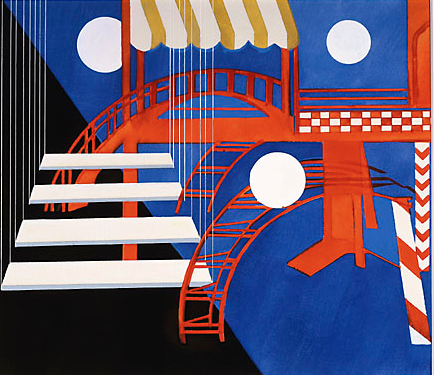

The Russian avant-garde emerged as the revolution dissolved the nation-state and made chaos an everyday reality. The past burned as the present moment magnified to harbor the uncertain future. In the project of drawing the future from the present, these artists unilaterally rejected received forms: they considered their culture’s bourgeois past to be tainted by toxic ideology. The avant-garde chose to service the revolution by creating new forms to sculpt utopian subjectivity — to shape the minds of citizens into the image of their dream. One aspect of this was to aestheticize public space with architectural forms derived from and reflective of their utopian ideals. They had to define space itself in new ways to enact their mission. At the edge of the present moment, chaos became freedom, total potentiality.
The gallery on the second floor of Webster Hall is a powerful display of these artists’ unfettered idealism. Curated by Bettina Jungen from the Thomas P. Whitney ’37 collection at the Mead, this gallery presents a range of original work by such artists as Aleksander Rodchenko, Iakov Chernikhov, Liubov Popova, Wassily Kandinsky and Olga Rozanova. With the knowledge that this aesthetic became a form of propaganda under Stalinism, it’s almost eerie to encounter their original work at such length, to see the depth of their belief in this project. The jolt, verve and joy of progress — the excitement of the future at hand — is preserved here, though the works have a melancholic air as well, due to the century of violence rooted in this moment. It’s chastening to see these ideas reflected so purely. It’s worth the effort it takes to reconcile.
It is immediately clear that these artists thematize space to reflect their relationship to past and future at once. Upon entering the gallery, the radical architectural design of Iakov Chernikhov stands out in a display case to the left. In one undated piece only named “5,” he imagines a city composed of sheer, curved bodies. While the severe, blocky stilts of “Le Corbusier” elevate his metropolis above the ground, Chernikhov instead imagines lush red chevrons composed into transparent pyramids to serve the same idealistic function. The flat page is given depth through the curve of the city outward, allowing his fantastic city to approach reality. Each cylindrical building is windowed over its entire service, reflecting the transparency the avant-garde felt vital to Soviet objects.
Beside this work is a piece entitled “Gorod” [City] by Nataliya Goncharova, from 1920. Her lithographs are less meant to imagine new architectural forms — the buildings seen are extremely simple — but more to locate the human within a Futurist cityscape. Space collapses into a series of vectors on one page, breaking the slopes of roofs into diagonal lines that meet at the origin point for wailing animalistic forms above. Opposite is a print where turbines, buildings, wheels and shadows overlay and intersect with one another. Her works aren’t about utopia, but energy and constant imbalance, the engine of revolutionary development.
Most emblematic of how well this collection reflects its historical moment is the corner of the gallery, where an abstract composition from 1916 by Wassily Kandinsky hangs adjacent to a compass composition from 1915 by Aleksander Rodchenko. The Kandinsky piece is an “organic” abstraction, replete with knuckles, fingers, hair, liver spots, and other animalistic elements. Altogether, it forms a whole similar in shape to an anatomical heart. Beside it, Rodchenko’s piece is alike in shape but, in true Rodchenko fashion, entirely geometricized. It could not be further from “organic” as the compass forms clear arcs filled in with shadow. There is no human hand visible in its creation. The depth is uncertain, and the piece rejects meaning beyond the form itself.
The energetic discovery of form and development of the avant-garde’s aesthetic is fascinating to witness on these walls. History is tangible here; it’s buzzing from every surface as one engages with these artists at their furthest remove from the burden of representation. Turning to leave, however, one is struck by a monumental work of Socialist Realism — the Stalinist genre that demands adherence to party strictures — on a high surface that cannot be seen on first entering the room. It depicts Stalin in a neoclassical hall shaking hands with heads of state beneath a bust of Lenin. Everyone is the same height, and Stalin appears adequately glorified. After experiencing the avant-garde in its development, with its joyful lights from reality and its exploration of the unknown, this painting reflects the harsh reality that followed all of this. All of this creative energy was flattened and put to use under Stalin. It’s harsh to see, but moving. Only somewhat separate from that massive work, the dream of the avant-garde along the gallery walls is preserved in context. It’s a difficult history to grapple with.